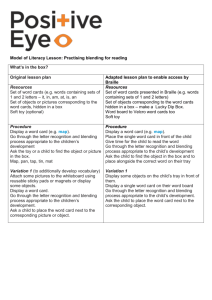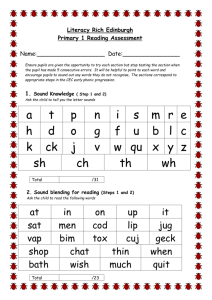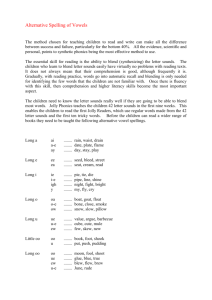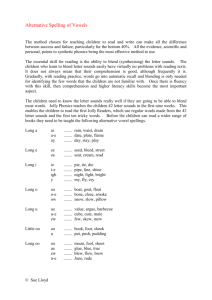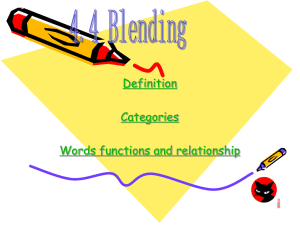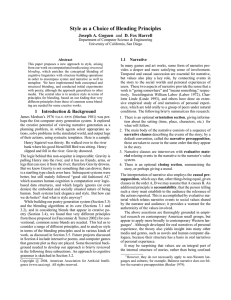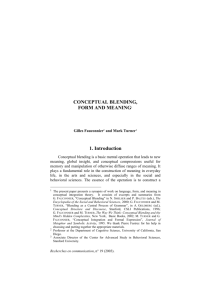Conceptual Blending - UCSD Cognitive Science
advertisement
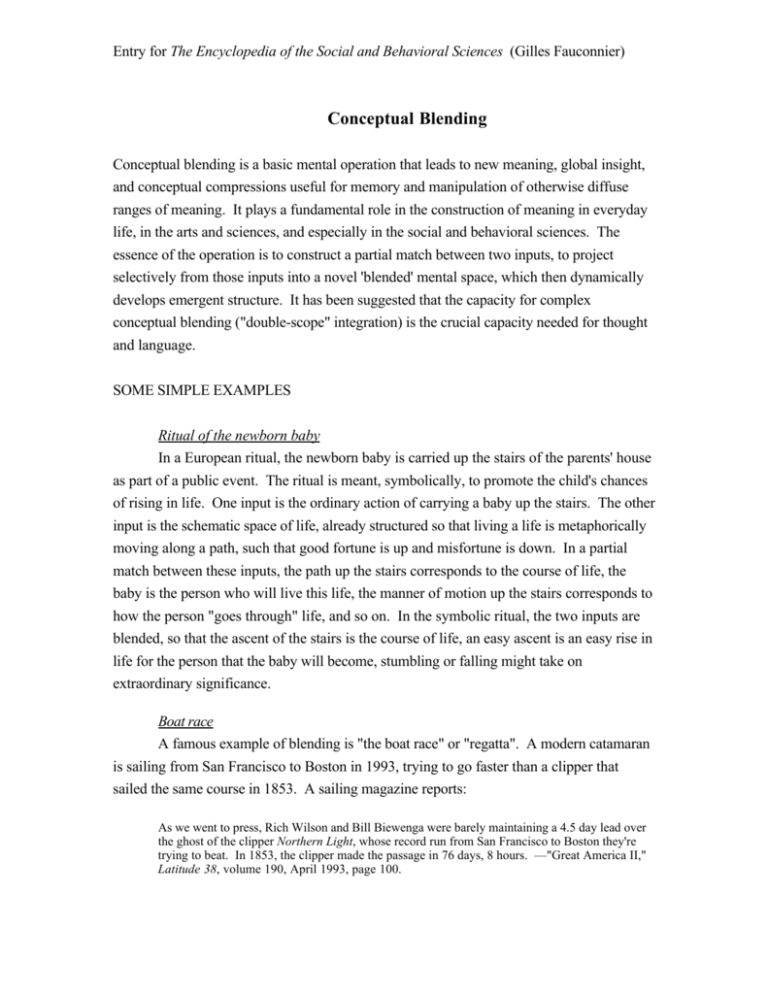
Entry for The Encyclopedia of the Social and Behavioral Sciences (Gilles Fauconnier) Conceptual Blending Conceptual blending is a basic mental operation that leads to new meaning, global insight, and conceptual compressions useful for memory and manipulation of otherwise diffuse ranges of meaning. It plays a fundamental role in the construction of meaning in everyday life, in the arts and sciences, and especially in the social and behavioral sciences. The essence of the operation is to construct a partial match between two inputs, to project selectively from those inputs into a novel 'blended' mental space, which then dynamically develops emergent structure. It has been suggested that the capacity for complex conceptual blending ("double-scope" integration) is the crucial capacity needed for thought and language. SOME SIMPLE EXAMPLES Ritual of the newborn baby In a European ritual, the newborn baby is carried up the stairs of the parents' house as part of a public event. The ritual is meant, symbolically, to promote the child's chances of rising in life. One input is the ordinary action of carrying a baby up the stairs. The other input is the schematic space of life, already structured so that living a life is metaphorically moving along a path, such that good fortune is up and misfortune is down. In a partial match between these inputs, the path up the stairs corresponds to the course of life, the baby is the person who will live this life, the manner of motion up the stairs corresponds to how the person "goes through" life, and so on. In the symbolic ritual, the two inputs are blended, so that the ascent of the stairs is the course of life, an easy ascent is an easy rise in life for the person that the baby will become, stumbling or falling might take on extraordinary significance. Boat race A famous example of blending is "the boat race" or "regatta". A modern catamaran is sailing from San Francisco to Boston in 1993, trying to go faster than a clipper that sailed the same course in 1853. A sailing magazine reports: As we went to press, Rich Wilson and Bill Biewenga were barely maintaining a 4.5 day lead over the ghost of the clipper Northern Light, whose record run from San Francisco to Boston they're trying to beat. In 1853, the clipper made the passage in 76 days, 8 hours. —"Great America II," Latitude 38, volume 190, April 1993, page 100. Informally, there are two distinct events in this story, the run by the clipper in 1853 and the run by the catamaran in 1993 on (approximately) the same course. In the magazine quote, the two runs are merged into a single event, a race between the catamaran and the clipper's "ghost". The two distinct events correspond to two input mental spaces, which reflect salient aspects of each event: the voyage, the departure and arrival points, the period and time of travel, the boat, its positions at various times. The two events share a more schematic frame of sailing from San Francisco to Boston; this is a "generic" space, which connects them. Blending consists in partially matching the two inputs and projecting selectively from these two input spaces into a fourth mental space, the blended space: Generic space cross-space mapping Input space 1 Input space 2 selective projection Blended space In the blended space, we have two boats on the same course, that left the starting point , San Francisco, on the same day. Pattern completion allows us to construe this situation as a race (by importing the familiar background frame of racing and the emotions that go with it). This construal is emergent in the blend. The motion of the boats is structurally constrained by the mappings. Language signals the blend explicitly in this case by using the expression "ghost-ship." By "running the blend" imaginatively and dynamically — by unfolding the race through time — we have the relative positions of the boats and their dynamics. Crucially, the blended space remains connected to the inputs by the mappings, so that real inferences can be computed in the inputs from the imaginary situation in the blended space. For example, we can deduce that the catamaran is going faster overall in 1993 than the clipper did in 1853, and more precisely, we have some idea ("four and a half days") of their relative performances. We can also interpret the emotions of the catamaran crew in terms of the familiar emotions linked to the frame of racing. The "boat race" example is a simple case of blending. Two inputs share structure. They get linked by a cross-space mapping and projected selectively to a blended space. The projection allows emergent structure to develop on the basis of composition, pattern completion (based on background models), and elaboration ("running the blend"): Clinton and Roosevelt The type of conceptual blend just discussed (technically called a "mirror network" because the same frame organizes both inputs) is very general. For example, a political comment on Clinton's presidency after he had been in office a few months might have been: By this point, Roosevelt was far ahead of Clinton. The two inputs are Roosevelt's and Clinton's presidencies. They are mapped onto each other in a natural way: starting points, mid-points, and so on are matched. In the blend, Roosevelt and Clinton are brought together within the same time frame, so that they are competing against each other. Blends of this sort are routinely elaborated for reasoning purposes in political analysis. Fictive motion Languages have means of describing static scenes in terms of fictive motion: The fence runs all the way down to the river. This works by having an 'imaginary' trajector move along the relevant dimension of an object, in this case the fence, or along some 'imaginary' path linking two objects. This is a remarkable mode of expression: it conveys motion and immobility at the same time. Objective immobility is expressed along with perceptual or conceptual motion. This apparent contradiction is a consequence of conceptual blending, which allows several connected, but heterogeneous mental spaces to be maintained simultaneously within a single mental construction. An input space containing a static scene of a fence and a river is blended with an input space that contributes a moving trajector on a path with a reference point. Counterfactuals Human thought depends heavily on the capacity for counterfactual thought, and counterfactuals are complex blends. Most of us can effortlessly understand statements like "In France, Watergate would not have hurt Nixon." This counterfactual is intended to highlight some differences between the American and French cultural and political systems. It is a blend that brings in aspects of the French system from one input and the Watergate scandal and President Nixon from the other. In the blend, we have a Watergate-like situation in France. Running this blend delivers attitudes quite different from those in the American input, and so in the blend, the president is not harmed. Counterfactuals can blend frames and identities in powerful ways (If I were you, ...). Such blends have been shown to play a major role for reasoning in the natural and social sciences. Computer Interfaces A nice example of conceptual blending in action and design is the "desktop" interface, in which the computer user moves icons around on a simulated desktop, gives alphanumeric commands, and makes selections by pointing at options on menus. Users recruit from their knowledge of office work, interpersonal commands, pointing, and choosing from lists. All of these are "inputs" to the imaginative invention of a blended scenario that serves as the basis for integrated performance. Once this blend is achieved, it delivers an amazing number of multiple bindings across quite different elements, bindings that seem, in retrospect, entirely obvious. A configuration of continuous pixels on the screen is bound to the concept "folder," no matter where that configuration occurs on the screen. Folders have identities, which are preserved. The label at the bottom of the folder in one view of the desktop corresponds to a set of words in a menu in another view. Pushing a button twice corresponds to opening. Pushing a button once when an arrow on the screen is superimposed on a folder corresponds to "lifting into view." Of course, in the technological device that makes the blend possible, namely the computer interface, there is no ordinary lifting, moving, or opening happening at all, only variations in the illumination of a finite and arranged number of pixels on the screen. The blend is not the screen: the blend is an imaginative mental creation that lets us use the computer hardware and software effectively. In the blend, there is lifting, moving, opening, and so on happening, but imported not from the technological device at hand, which is only a medium, but from another input, namely our mental conception of work we do on a real desktop. THE NETWORK MODEL Conceptual blending is described and studied scientifically in terms of integration networks. In its most basic form, a conceptual integration network consists of four connected mental spaces: two partially matched input spaces, a generic space consituted by structure common to the inputs, and the blended space. The blended space is constructed through selective projection from the inputs, pattern completion, and dynamic elaboration. The blend has emergent dynamics. It can be "run", while its connections to the other spaces remain in place. Neurobiologically, it has been suggested that elements in mental spaces correspond to activated neural assemblies and that linking between elements corresponds to neurobiological binding (e.g. co-activation). On this view, mental spaces are built up, interconnected, and blended in working memory by activating structures available from long-term memory. Mental spaces can be modified dynamically as thought and discourse unfold. Four main types of integration networks have been distinguished: Simplex, Mirror, Single-Scope, Double-Scope. In Simplexes, one input consists of a frame and the other consists of specific elements. A frame is a conventional and schematic organization of knowledge such as "buying gasoline." In Mirrors, a common organizing frame is shared by all spaces in the network. In Single-Scopes, the organizing frames of the inputs are different, and the blend inherits only one of those frames. In Double-Scopes, essential frame and identity properties are brought in from both inputs. Double-Scope Blending can resolve clashes between inputs that differ fundamentally in content and topology. This is a powerful source of human creativity. The main types of networks just mentioned are actually prototypes along a continuum that anchors our intuitive everyday notions about meaning to a unified understanding of the unconscious processes at work. Varieties of meaning traditionally considered unequal or even incommensurable—categorizations, analogies, counterfactuals, metaphors, rituals, logical framing, grammatical constructions—can all be situated on this continuum. Conceptual blending has been shown to operate in the same way at the highest levels of scientific, artistic, and literary thought, and at the supposedly lower levels of elementary understanding and sentence meaning. Elaborate blending is at work in superficially very simple expressions like "safe gun" vs. "safe child", "guilty pleasures", "caffeine headache", or "money problem". Emergent structure arises routinely, as in "This surgeon is a lumberjack" which suggests that the surgeon is incompetent although incompetence is neither a feature of surgeon nor of lumberjack. There are opposing pressures within an integration network to maximize topology matching, integration, unpacking of the blend, web connections, compression, and intentionality. More complex integration networks ("multiple blends") allow multiple input spaces, and successive blending in which blends at one level can be inputs at another. COMPRESSION Blending is a remarkable tool of compression over vital relations like time, space, cause-effect, identity, and change. In the Newborn Ritual, time is compressed: an entire lifetime becomes, in the blend, the short time it takes to climb the stairs; in the Nixon counterfactual, space is compressed (Watergate can be in France); in the Desktop interface, the complex sequence of events which move the mouse horizontally and cause an apparent vertical motion of the arrow (and other 'objects') on the screen is compressed and integrated into a single action — moving the arrow. This is a compression of space, causeeffect, and change. RANGE OF THE COGNITIVE OPERATION A systematic study of conceptual blending was initiated in 1993 by Gilles Fauconnier and Mark Turner [3], who discovered the structural uniformity and wide application of the notion. Since then, important work has been done on the theory of conceptual blending [1], and its empirical manifestations in mathematics [10], social science [11], [12], [13], literature [4], [9], [14], linguistics [7], [8], and music [16]. There have been proposals for the mathematical and computational modeling of the operation [5], [15], and experimental research within neuroscience on the corresponding neural and cognitive processes [1], [6]. Additional information and an extensive bibliography can be found on website [17]. REFERENCES [1] Coulson, Seana. In Press. Semantic Leaps: Frame-shifting and Conceptual Blending in Meaning Construction. New York and Cambridge: Cambridge University Press. [2] Fauconnier, Gilles. 1997. Mappings in Thought and Language. New York and Cambridge: Cambridge University Press. [3] Fauconnier, Gilles and Turner, Mark . 1998. "Conceptual Integration Networks." Cognitive Science. Volume 22, number 2 (April-June 1998), pages 133-187. [4] Freeman, Margaret. 1997. "Grounded spaces: Deictic -self anaphors in the poetry of Emily Dickinson," Language and Literature, 6:1, 7-28. [5] Goguen, Joseph. 1999. "An Introduction to Algebraic Semiotics, with Application to User Interface Design." Computation for Metaphor, Analogy, and Agents. Edited by Chrystopher Nehaniv. Berlin: Springer-Verlag, pages 242-291. A volume in the series Lecture Notes in Artificial Intelligence. [6] Grush, Rick and Nili Mandelblit. 1997. "Blending in language, conceptual structure, and the cerebral cortex." The Roman Jakobson Centennial Symposium: International Journal of Linguistics Acta Linguistica Hafniensia Volume 29:221-237. Per Aage Brandt, Frans Gregersen, Frederik Stjernfelt, and Martin Skov, editors. C.A. Reitzel: Copenhagen. [7] Lidell, Scott K. 1998. "Grounded blends, gestures, and conceptual shifts." Cognitive Linguistics, 9. [8] Mandelblit, Nili. 1997. Grammatical Blending: Creative and Schematic Aspects in Sentence Processing and Translation. Ph.D. dissertation, UC San Diego. [9] Oakley, Todd. 1998. "Conceptual blending, narrative discourse, and rhetoric." Cognitive Linguistics, 9-: 321-360. [10] Robert, Adrian . 1998. "Blending in the interpretation of mathematical proofs." Discourse and Cognition.. Edited by Jean-Pierre Koenig. Stanford: Center for the Study of Language and Information (CSLI) [distributed by Cambridge University Press]. [11] Sweetser, Eve. under review. "Blended Spaces and Performativity". Cognitive Linguistics. [12] Turner, Mark. 2000. "Backstage Cognition in Reason and Choice." In Andrew Lupia, Mathew McCubbins, and Samuel Popkin, editors, Elements of Reason: The Science of the Mind and the Limits of Political Rationality Cambridge: Cambridge University Press. [13] Turner, Mark . 1996. "Conceptual Blending and Counterfactual Argument in the Social and Behavioral Sciences," in Philip Tetlock and Aaron Belkin, editors, Counterfactual Thought Experiments in World Politics. Princeton, N.J.: Princeton University Press. [14] Turner, Mark. 1996. The Literary Mind. Oxford University Press [15] Veale, Tony. 1999. "Pragmatic Forces in Metaphor Use: The Mechanics of Blend Recruitment in Visual Metaphors." Computation for Metaphor, Analogy, and Agents. Edited by Chrystopher Nehaniv. Berlin: Springer-Verlag, pages 37-51. A volume in the series Lecture Notes in Artificial Intelligence. [16] Zbikowski, Lawrence. 1999. "The blossoms of 'Trockne Blumen': Music and text in the early nineteenth century," Music Analysis 18/3 (October 1999): 307-345. Manuscript. Zbikowski offers a graduate seminar on conceptual mapping and blending in the department of music at the University of Chicago. [17] Website for Conceptual Blending: http://www.wam.umd.edu/~mturn/WWW/blending.html
